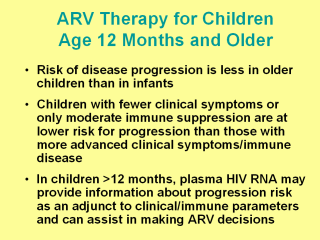| front |1 |2 |3 |4 |5 |6 |7 |8 |9 |10 |11 |12 |13 |14 |15 |16 |17 |18 |19 |20 |21 |22 |23 |24 |25 |26 |27 |28 |29 |review |
 |
Since the risk of disease progression slows in
children over age 1 year, the option of deferring treatment can be
considered for older children. While antiretroviral therapy is indicated for
children with symptomatic HIV infection, independent of immunologic and
virologic parameters, the degree of clinical symptoms suggesting a need for
therapy is unclear. Children with clinical AIDS (Clinical Category C) or severe immune suppression (Immune Category 3) are at high risk of progression and death, and treatment is recommended for all such children, regardless of virologic status. Children over age 12 months with mild to moderate clinical symptoms (Clinical Category A or B) or moderate immune suppression (Immune Category 2) are at lower risk for progression than those with severe clinical and immunologic findings [94]. In children with mild-moderate clinical symptoms or immune suppression, the level of plasma HIV RNA may provide useful information in terms of risk for progression. Studies have shown that older children with HIV RNA levels of >100,000 copies/mL are at high risk for mortality (Table 4) [50,51]. In the US and European meta-analysis discussed earlier, the 1-year risk of progression to AIDS or death rose sharply for children older than 1 year of age when HIV RNA levels were >100,000 copies/mL [83]. |